In this article:
Yoga helps to eliminate stress, and it is the perfect antidote to sitting at a desk all day. Yoga can reduce stress and tension and improves concentration and the ability to focus. It also detoxifies the body and tones the muscles.
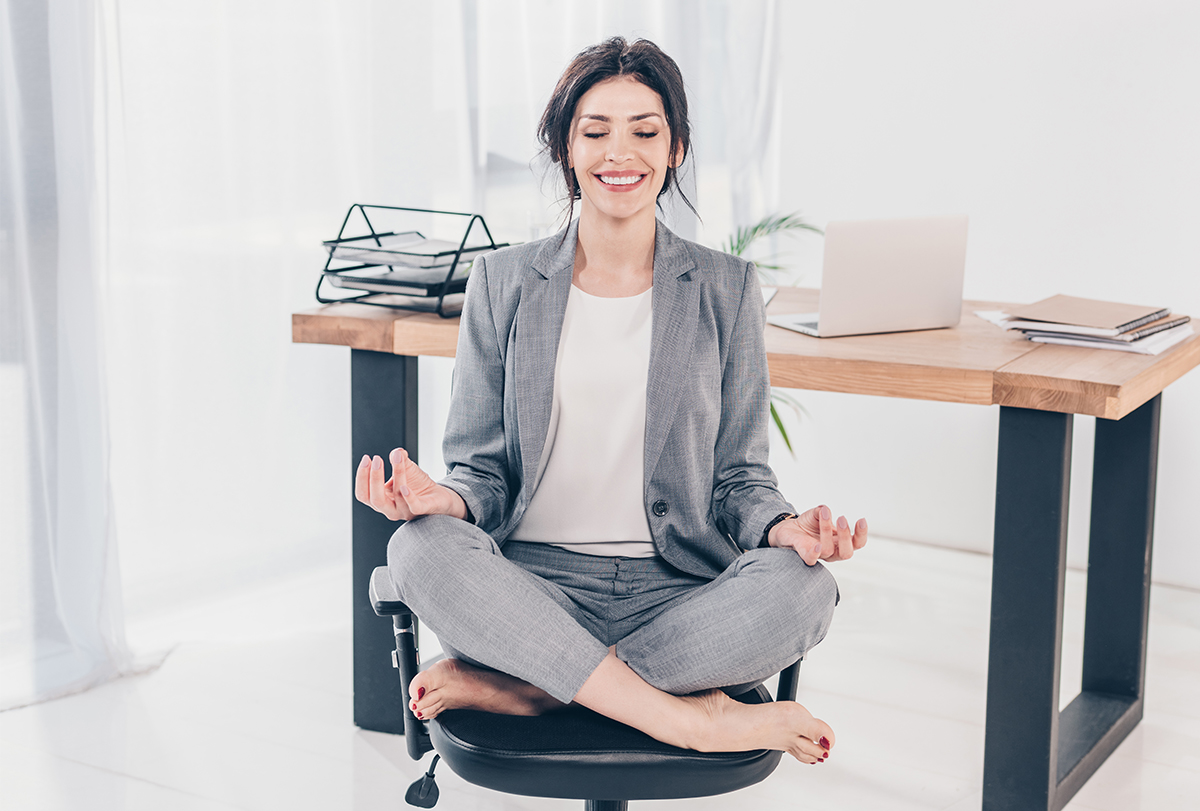
Common Health Problems Caused by a Sedentary Lifestyle
There are many health concerns associated with a sedentary lifestyle. Here are some of them:
- Muscle weakness: Without use, muscles get weak. (1) This makes it more difficult to enjoy or feel motivated to do other physical activities, which further promotes a sedentary lifestyle.
- Heart disease: Physical inactivity increases your risk for cardiovascular disease, high blood pressure, stroke, and heart attack. It also leads to poor circulation. (2)
- Weight gain: Staying active helps you maintain a healthy weight and stay in shape mainly through two mechanisms: burning extra calories and improving your metabolism rate. Conversely, leading a sedentary life entails that you consume more calories than you burn which ultimately amounts to weight gain. Plus, the lack of activity also hinders the breakdown of fats and sugars inside the body by slowing your metabolism rate. Thus, people who are generally physically inactive are more likely to be overweight or obese which triggers a number of other health issues. (3)
- Mental health problems: Sedentary lifestyles increase the risk for mental health issues, such as anxiety and depression. (4)
- Sleep problems: Regular activity helps you fall asleep and stay asleep through the night, so not getting regular exercise can affect your quality of sleep.
Most Effective Yoga Poses to Perform at Your Work Desk
There are so many supportive yoga poses that can be done right at your desk! Studies have shown that stretching before or during work hours can help employees perform better at their job, calm their mind, and improve their problem-solving abilities. (5)
1. Wrist and finger stretch
Typing and thumbing away on your cell phone and computer can take a toll on your hands and wrists. The flexibility of your hands and their twenty-nine joints causes them to be vulnerable to injury, which makes effective hand use extremely important.
Be mindful not to hyperextend your elbows when doing the wrist and finger stretch with straight arms.
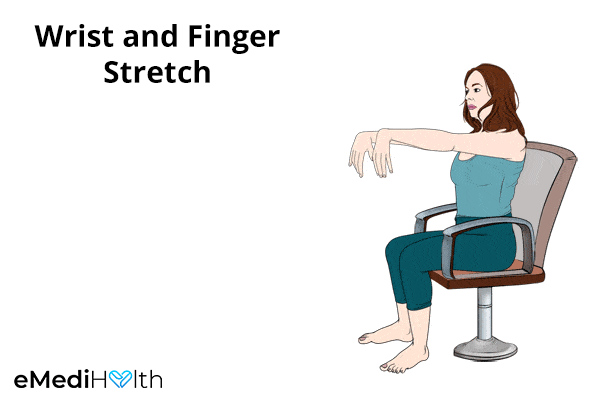
How to do it:
- Sit in your chair with your spine straight.
- Stretch your arms straight in front, and circulate your wrists first inward and then outward.
- Spread open your fingers and then close them to form a fist, at least 5–10 times.
- Put your hands on your desk with your palms toward the ceiling and fingers toward you.
- Gently press your hands downward to counterstretch your wrists and forearms.
- Bring your arms to your sides and rapidly shake your wrists to loosen them.
2. Chair cat and cow pose
The benefits of the chair cat and cow pose are it makes the spine more supple and gets you to relax your back and shoulders. It offers a counterstretch to the position your spine is in most of the day when you are sitting at a desk.
How to do it:
- Sit upright at the front edge of your chair with your feet pressed firmly in the ground at hip-width distance, your knees and ankles in a straight line, and your toes pointing forward.
- Put your palms on your knees or thighs.
- Breathe in and stretch out your chest and shoulders.
- Squeeze your shoulder blades together and push them down toward your buttocks to create an arch in the lower back.
- Continue to inhale as you raise your head up and backward. This will complete the cow pose.
- To shift into the cat pose, breathe out and draw in your upper body, starting from the lower back, the abdomen, and then the chest. You need to round your shoulders and drop your head down so that your chin rests on your chest.
- Alternate between the cat and cow poses 8–10 times.
- Come to a neutral spine with an inhalation, and relax.
3. Chair raised-hand pose
The seated raised-hand pose works out your entire back and front of the body as well as your upper limbs. It elongates the spine to stretch out your psoas, lower back, and some hip muscles while also stimulating your abdominal muscles, chest, and rib. (6)
It involves raising your arms to stretch the torso upward, which helps relieve the pressure from your shoulders and neck while also flexing your elbows, wrists, and fingers.
Doing this simple stretching exercise regularly can help strengthen your back and shoulders.

How to do it:
- Sit up straight in your chair.
- While taking a deep breath, extend your arms out to the sides and raise them toward the ceiling.
- Join your palms overhead and look up toward your thumbs.
- Let your shoulder blades slide down your back.
- Draw in your chest and abdomen to relieve pressure from your lower back.
- Maintain this position for 5–10 deep breaths.
- If you feel any tightness in the neck, bring down your head to gaze straight in front with your chin parallel to the ground.
- Come out of the pose while releasing your breath.
4. Seated crescent moon pose
Sitting at your desk hunched over your computer for long periods puts a lot of strain on your neck and shoulder muscles. This can give rise to a lot of pain and discomfort, while also ruining your overall posture.
The seated crescent moon is a simple yoga pose that can help lengthen your spine to stretch out your shoulder and neck muscles as well as straighten your posture.
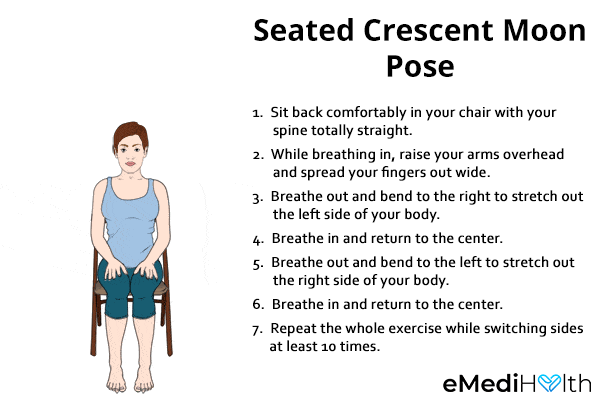
How to do it:
- Sit back comfortably in your chair with your spine totally straight.
- While breathing in, raise your arms overhead and spread your fingers out wide.
- Breathe out and bend to the right to stretch out the left side of your body.
- Breathe in and return to the center.
- Breathe out and bend to the left to stretch out the right side of your body.
- Breathe in and return to the center.
- Repeat the whole exercise while switching sides at least 10 times.
5. Sit and stand chair pose
Sitting at your desk all day renders your glutes and hamstrings weak, stiff, and even numb due to prolonged inactivity. As a result, you need to take the support of your upper back and neck muscles to stand back up. This undue exertion can strain your back or neck muscles as they are not used to bearing the load of your body.
But a simple 2–step yoga pose called the sit and stand pose can help rejuvenate and strengthen your leg muscles and offer some much-need reprieve to your upper body.
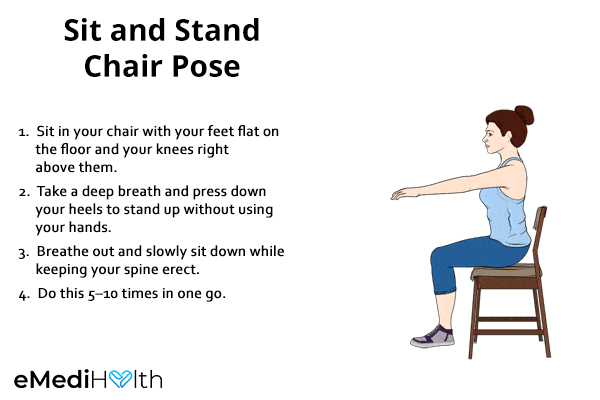
How to do it:
- Sit in your chair with your feet flat on the floor and your knees right above them.
- Take a deep breath and press down your heels to stand up without using your hands.
- Breathe out and slowly sit down while keeping your spine erect.
- Do this 5–10 times in one go.
6. Seated forward bend
The seated forward bend helps to open the lower back, shoulders, neck, and hips in order to release the tightness and stiffness of the muscles. It’s a quick way to awaken and open the upper body joints, nerves, and muscles to release stiffness.
As the blood flows toward the head and releases all the heaviness at the base of the neck, it helps bring the feeling of being light and relaxed.
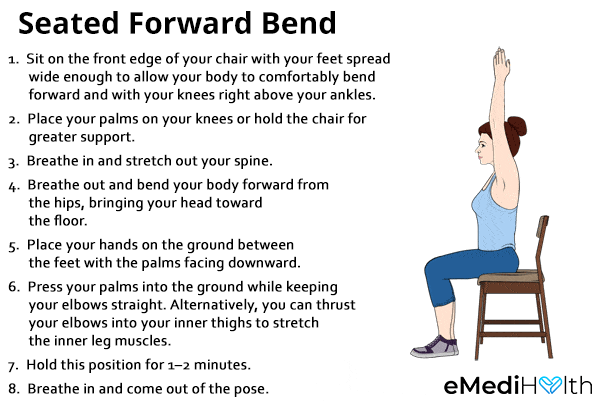
How to do it:
- Sit on the front edge of your chair with your feet spread wide enough to allow your body to comfortably bend forward and with your knees right above your ankles.
- Place your palms on your knees or hold the chair for greater support.
- Breathe in and stretch out your spine.
- Breathe out and bend your body forward from the hips, bringing your head toward the floor.
- Place your hands on the ground between the feet with the palms facing downward.
- Press your palms into the ground while keeping your elbows straight. Alternatively, you can thrust your elbows into your inner thighs to stretch the inner leg muscles.
- Hold this position for 1–2 minutes.
- Breathe in and come out of the pose.
7. Chair pigeon pose
Prolonged sitting in one position can make your hip muscles stiff, which can make movement difficult, disrupt your posture, and even trigger pain that may radiate throughout your back and legs. This can be especially problematic for people with preexisting back pain or sciatica.
The pigeon pose can help relax your hip muscles and stretch out your spine to relieve your strained muscles.
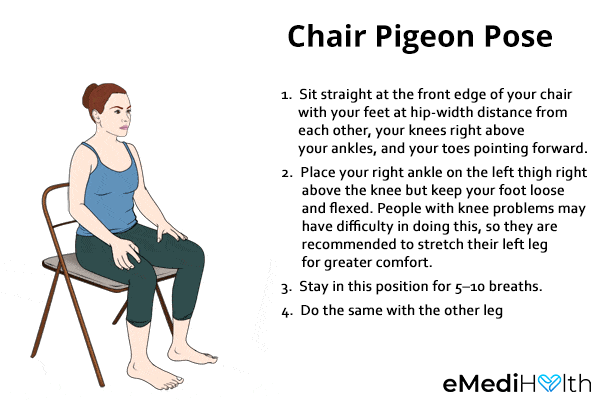
How to do it:
- Sit straight at the front edge of your chair with your feet at hip-width distance from each other, your knees right above your ankles, and your toes pointing forward.
- Place your right ankle on the left thigh right above the knee but keep your foot loose and flexed. People with knee problems may have difficulty in doing this, so they are recommended to stretch their left leg for greater comfort.
- Stay in this position for 5–10 breaths.
- Do the same with the other leg.
8. Hamstring stretch
When you spend most of your day sitting at a desk, your hamstrings tend to stiffen as they don’t go through their full range of motion. Tight hamstrings can get pulled or ruptured easily by any sudden activity. Plus, they can add to the pain in your back, hips, knees, and foot/ankle.
This yoga pose allows you to gently stretch your hamstrings while remaining in a seated position. Flexing your hamstrings this way will also stretch out your lower-back muscles for added relief.
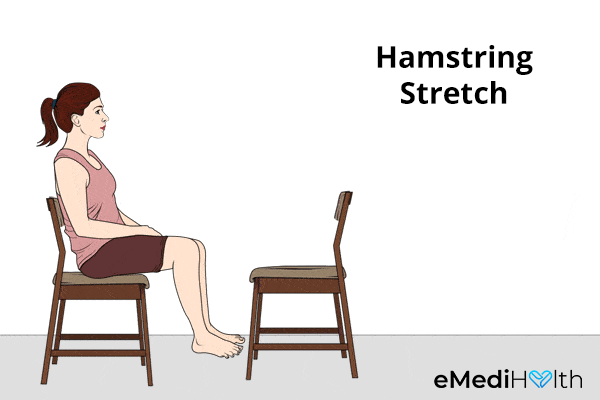
How to do it:
- Place two chairs facing each other.
- Sit on the edge of one chair with your spine erect.
- Lift your right heel and place it on the opposite chair.
- Breathe in as you raise both your arms up toward the ceiling and then exhale.
- Fold your upper body forward (rather than down) to grab your toes, ankle, or wherever you can reach comfortably without pulling your shoulder muscles.
- Keep your right knee bent if there is pulling on the back of the knee.
- Maintain this position for 5–10 breaths.
- Do the same with the other side.
9. Cow face arms pose
The cow face arms pose stretches your shoulders and arms and releases tension from the shoulders and front of the chest, which gets tight from rounding over your computer.
It also facilitates deep breathing by opening the chest and intercostal muscles and helps to eliminate rounded shoulders, therefore improving posture.
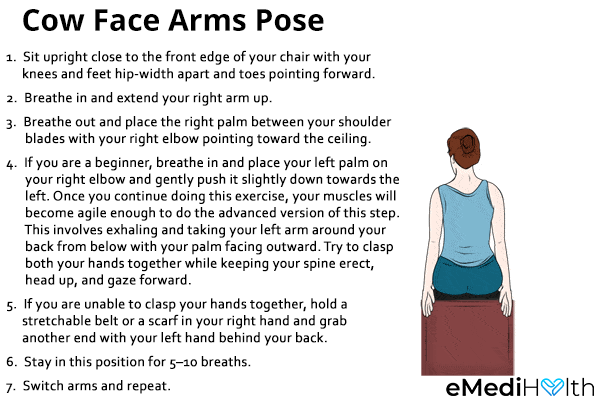
How to do it:
- Sit upright close to the front edge of your chair with your knees and feet hip-width apart and toes pointing forward.
- Breathe in and extend your right arm up.
- Breathe out and place the right palm between your shoulder blades with your right elbow pointing toward the ceiling.
- If you are a beginner, breathe in and place your left palm on your right elbow and gently push it slightly down towards the left. Once you continue doing this exercise, your muscles will become agile enough to do the advanced version of this step. This involves exhaling and taking your left arm around your back from below with your palm facing outward. Try to clasp both your hands together while keeping your spine erect, head up, and gaze forward.
- If you are unable to clasp your hands together, hold a stretchable belt or a scarf in your right hand and grab another end with your left hand behind your back.
- Stay in this position for 5–10 breaths.
- Switch arms and repeat.
10. Seated twist pose
The seated twist pose stretches out your back muscles to relieve tension and pain. Plus, it stimulates your abdominal organs.
This yoga pose is best done in a chair for more freedom of movement, but some people choose to do it on the floor, which does not allow your body to go as deeply as the former.

How to do it:
- Sit up straight in your chair with the side of your body facing the back of the chair, your sit bones pressed firmly into the seat, your feet and knees at hip-width distance, and your toes pointing forward.
- Draw in a deep breath while keeping your spine erect.
- Release your breath and twist your upper body to the right side from the bottom of your spine.
- Bring your hands to the back of the chair.
- Loosen your shoulders.
- Push the bottom of the right shoulder blade toward the spine while moving the bottom of the left shoulder blade away from the spine so that both the shoulders form a straight line.
- After rotating your shoulder blades to their full extent, turn your head to look over your left shoulder.
- Take a few deep breaths, and then come back to the starting position.
- Do the same on the other side.
Stress Management Through Yoga
It is natural to be stressed about your work, which can sometimes be a motivator to perform better. But some people take on too much pressure such that it starts hampering their work quality and general well-being.
If you let the stress overwhelm you, you won’t be able to focus or function to the best of your abilities. The inability to do your best will make you more frustrated and tense, inducing a vicious cycle that can push you to total burnout.
Thus, it is important to acquaint yourself with a few symptoms that could indicate that work-related stress is taking a toll on you. These include undue fatigue, frequent headaches, sore muscles, lack of focus or general interest in work tasks, and generally feeling anxious, depressed, or irritable.
If your job is making you miserable, it can be very difficult to excel at it. So, it’s best to identify the root of the problem and then correct it. To that end, you need to look inward and evaluate what exactly is giving you stress and then look for ways to manage those stressors.
One popular way to combat job-related stress is to practice regular yoga. This ancient form of exercise mainly rests on stretching and deep breathing, which can help relieve the physical as well as psychological stress from your body. (7)
Importance of Deep Breathing During Yoga
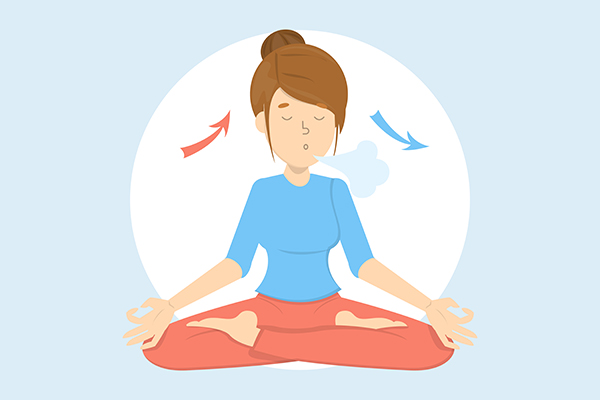
It is recommended to hold each pose for 2–5 full, long breaths. Deepening the breath will support you in finding more depth in most of the poses, and the exhale helps to release the tension that has been stored in tight muscles.
It is believed that the pose really begins when you want to come out of it, so take an extra full breath and release anywhere you might be clenching.
Final Word
Yoga is a mindful form of exercise that makes you disconnect from your surroundings and focus inwards on your breathing. The steps of each asana are coordinated with a rhythmic flow of deep inhales and exhales.
In fact, slow deep breathing is the cornerstone of all yoga exercises. It not only relaxes both your mind and body, but also enables you to listen to your body while performing the poses. The other important aspect of yoga is gentle stretching which helps loosen your stiff muscles and joints for greater flexibility and comfort.
While stretching is bound to cause some discomfort, it should not be painful. Also, don’t attempt a difficult exercise if you are not ready for it. Start off easy, and then move to the more complicated poses as your body becomes more limber with time.
Don’t rush through the exercise and don’t exert undue force. Remember to sit upright, keeping the spine as long as possible and avoiding straining or holding your breath.
- Was this article helpful?
- YES, THANKS!NOT REALLY


